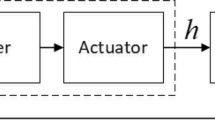Abstract
Stopping maneuver is an important research topic in ship maneuverability. The stopping ability of ship is not only related to the hydrodynamic characteristics of hull, rudder and propeller, but also related to the capacity of main engine. However, there are few researches on the capacity of main engine under reversed propulsion condition. In the paper, a numerical water tank is established to simulate the propeller loads using the computational fluid dynamics (CFD) software STAR CCM+. The numerical model is firstly validated by experimental data, and then is used to investigate the propeller loads on a full-scale model with different ship speed and propeller speed. By dimensionless, the relations between the advance coefficient and the load coefficients are shown as J - KT curves and J - KQ curves. Furtherly, the flow structures near the propeller and the pressure on the propeller with different J values are investigated. The simulations reveal that the flow velocities induced by the reversed propulsion of the propeller is similar to the wake flow by ship with J = -0.49. That is the reason for the minimum points of J - KT and J - KQ curve occurring in cases with J = -0.49. Subsequently, the capacity of the main engine and the output load of the propeller are considered comprehensively. The relations between the ship speeds and the maximum output loads on the propeller are discussed in details.
Similar content being viewed by others
References
Sun W., Yang L., Wei J. et al. Numerical analysis of propeller loading with a coupling RANS and potential approach [J]. Proceedings of the Institution of Mechanical Engineers Part C: Journal of Mechanical Engineering Science, 2019, 233(18): 6383–6396.
Lu D. Simulation on ship stopping motion by reverse propulsion [J]. Ship Science and Technology, 2007, 29(4): 110–113(in Chinese).
Zhang W., Xu Y. Q., Chu M. S. Research on process analysis and calculation of the reverse stopping distance for large ships [J]. China Harbour Engineering, 2019, 39(1): 6–10(in Chinese).
Sun H. Modeling and simulation of ship's motion in propeller reversing [D]. Master Thesis, Dalian, China: Dalian Maritime University, 2007(in Chinese).
Zou G. Q., Gan S. W., Lei W. Reason analysis of engine flameout in the crash stop ahead [J]. Ship and Ocean Engineering, 2013, 42(6): 121–123(in Chinese).
Sun W., Yang L., Wei J. et al. Numerical analysis of propeller loading with a coupling RANS and potential approach [J]. Journal of Mechanical Engineering Science, 2019, 233(18): 6383–6396.
Huang H., Shen A. D., Chu J. X. Research on propeller dynamic load simulation system of electric propulsion ship [J]. China Ocean Engineering, 2013, 27(2): 255–263.
Amini H., Sileo L., Steen S. Numerical calculations of propeller shaft loads on azimuth propulsors in oblique inflow [J]. Journal of Marine Science and Technology, 2012, 17(4): 403–421.
Zong Z., Hong Z., Zhang H. et al. An investigation of load change of propeller in a four-propulsion vessel using CFD [J]. Journal of Marine Science and Technology, 2018, 23(1): 122–131.
Zheng X., Shao S., Khayyer A. et al. Corrected first-order derivative ISPH in water wave simulations [J]. Coastal Engineering Journal, 2017, 59(1): 1750010.
Zheng X., Ma Q., Shao S. et al. An improved 2D+t incompressible smoothed particle hydrodynamics approach for high-speed vessel waves [J]. Journal of Coastal Research, 2019, 35(5): 1106–1119.
Gong K., Shao S., Liu H. et al. Cylindrical smoothed particle hydrodynamics simulations of water entry [J]. Journal of Fluids Engineering, 2019, 141(7): 071303.
Li Z. W., Huai W. X., Qian Z. D. Study on the flow field and concentration characteristics of the multiple tandem jets in crossflow [J]. Science China Technological Sciences, 2012, 55(10): 2778–2788.
Huai W. X., Wang Z. W., Qian Z. D. et al. Numerical simulation of sandy bed erosion by 2D vertical jet [J]. Science China Technological Sciences, 2011, 54(12): 3265–3274.
Fan X., Zhang J., Liu H. Numerical analysis on the secondary load cycle on a vertical cylinder in steep regular waves [J]. Ocean Engineering, 2018, 168: 133–139.
Tahara Y., Tohyama S., Katsui T. CFD-based multiobjective optimization method for ship design [J]. International Journal for Numerical Methods in Fluids, 2006, 52(5): 499–527.
Demirel Y. K., Khorasanchi M., Turan O. et al. A CFD model for the frictional resistance prediction of antifouling coatings [J]. Ocean Engineering, 2014, 89: 21–31.
Wang C., Sun S., Li L. et al. Numerical prediction analysis of propeller bearing force for full-scale hull-propeller-rudder system [J]. International Journal of Naval Architecture and Ocean Engineering, 2016, 8(6): 589–601.
Castro A. M., Carrica P. M., Stern F. Full scale selfpropulsion computations using discretized propeller for the KRISO container ship KCS [J]. Computers and Fluids, 2011, 51(1): 35–47.
Tezdogan T., Demirel Y. K., Kellett P. et al. Full-scale unsteady RANS CFD simulations of ship behaviour and performance in head seas due to slow steaming [J]. Ocean Engineering, 2015, 97: 186–206.
Sun W., Hu Q., Hu S. et al. Numerical analysis of fullscale ship self-propulsion performance with direct comparison to statistical sea trail results [J]. Journal of Marine Science and Engineering, 2020, 8(1): 1–24.
Shen Z., Wan D., Carrica P. M. Dynamic overset grids in OpenFOAM with application to KCS self-propulsion and maneuvering [J]. Ocean Engineering, 2015, 108: 287–306.
Kim W. J., Van S. H., Kim D. H. Measurement of flows around modern commercial ship models [J]. Experiments in Fluids, 2001, 31(5): 567–578.
Carlton J. S. Marine propellers and proplusion [M]. London, UK: Butterworth-Heinemann, 2007.
Yang X., Cheng E. Research on stress test of large slanted propeller blade [J]. Ship and Ocean Engineering, 2004, 1: 1–9(in Chinese).
MAN B&W S50ME-C8.5-TII. Project guide electronically controlled two-stroke engines [R]. Munich, Germany: MAN B&W, 2014.
Author information
Authors and Affiliations
Corresponding author
Additional information
Projects supported by the Development Project of Ship Situational Intelligent Awareness System (Grant No. MC-201920-X01).
Biography: Xiang Fan (1989-), Male, Ph. D.
Rights and permissions
About this article
Cite this article
Fan, X., Tang, Jj., Zhang, Yx. et al. Numerical investigation of the ship propeller load under reversed propulsion condition. J Hydrodyn 33, 361–369 (2021). https://doi.org/10.1007/s42241-021-0024-x
Received:
Revised:
Accepted:
Published:
Issue Date:
DOI: https://doi.org/10.1007/s42241-021-0024-x




